FAA rules for OOP, this seems current ?
https://www.faa.gov/uas/commercial_operators/operations_over_people/
For sub 250gm . . . cat 1.
Even a mini /
mini 2 does not comply.
Maybe small FPV type nano / micro drones with ducted motor etc
- Category 1 small unmanned aircraft are permitted to operate over people, provided the small unmanned aircraft:
- Weigh 0.55 pounds or less, including everything that is on board or otherwise attached to the aircraft at the time of takeoff and throughout the duration of each operation.
- Contain no exposed rotating parts that would cause lacerations.
For larger Mavics etc
- Category 2 and Category 3 provide performance-based eligibility and operating requirements when conducting operations over people using unmanned aircraft that weigh more than .55 pounds but do not have an airworthiness certificate under part 21.
- In addition, for Category 2 operations, no remote pilot in command may operate a small unmanned aircraft in sustained flight over open-air assemblies unless the operation is compliant with RID.
- Category 3 small UAS have further operating restrictions. A remote pilot in command may not operate a small unmanned aircraft over open-air assemblies of human beings. Additionally, a remote pilot in command may only operate a small unmanned aircraft over people if:
- The operation is within or over a closed- or restricted-access site and all people on site are on notice that a small UAS may fly over them; or
- The small unmanned aircraft does not maintain sustained flight over any person unless that person is participating directly in the operation or located under a covered structure or inside a stationary vehicle that can provide reasonable protection from a falling small unmanned aircraft.
- Category 4 operations is an addition from the NPRM. This category allows small unmanned aircraft issued an airworthiness certificate under part 21 to operate over people, so long as the operating limitations specified in the approved Flight Manual or as otherwise specified by the Administrator, do not prohibit operations over people. Additionally, no remote pilot in command may operate a small unmanned aircraft in sustained flight over open-air assemblies unless the operation is compliant with Remote ID. To preserve the continued airworthiness of the small unmanned aircraft and continue to meet a level of reliability that the FAA finds acceptable for operating over people in accordance with Category 4, additional requirements apply.
- Note: Sustained flight over an open-air assembly includes hovering above the heads of persons gathered in an open-air assembly, flying back and forth over an open-air assembly, or circling above the assembly in such a way that the small unmanned aircraft remains above some part the assembly. ‘Sustained flight’ over an open-air assembly of people in a Category 1, 2, or 4 operation does not include a brief, one-time transiting over a portion of the assembled gathering, where the transit is merely incidental to a point-to-point operation unrelated to the assembly.
Cat 3, all depends what the terms closed - restricted site means, and how the people are notified ?
Is a public arena during a public performance a closed site ?
Participating directly ?
I thought it had been discussed a lot here, and that means participating in the drone operation ?
Pilot, spotter, film crew, etc.










